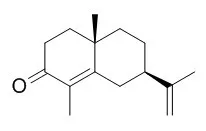| Cell Research: |
| J Ethnopharmacol. 2013 May 2;147(1):208-14. | | α-Cyperone, isolated from the rhizomes of Cyperus rotundus, inhibits LPS-induced COX-2 expression and PGE2 production through the negative regulation of NFκB signalling in RAW 264.7 cells.[Pubmed: 23500883] | The rhizomes of Cyperus rotundus (Cyperaceae) have been used in Asian traditional medicine for the treatment of several inflammatory diseases. However, the anti-inflammatory effects of α-cyperone, a major active compound of Cyperus rotundus, are poorly understood.
METHODS AND RESULTS:
PGE2 and cytokines released from cells were measured using an EIA assay kit. The expression of iNOS, COX-2, TNF-α, and IL-6 was measured by real-time RT-PCR and/or Western blot analysis. A luciferase assay was performed to measure the effect of α-cyperone on NFκB activity.
The n-hexane fraction of the 80% EtOH extract from the rhizomes of Cyperus rotundus was found to inhibit both NO and PGE2 production in RAW 264.7 cells. α-Cyperone isolated from the n-hexane fraction significantly inhibited PGE2 production by suppressing the LPS-induced expression of inducible COX-2 at both the mRNA and the protein levels. In contrast, α-cyperone had little effect on NO production and iNOS expression. Additionally, α-cyperone downregulated the production and mRNA expression of the inflammatory cytokine IL-6. Moreover, treatment with α-cyperone suppressed the transcriptional activity of NFκB and the nuclear translocation of the p65 NFκB subunit in LPS-induced RAW 264.7 cells.
CONCLUSIONS:
The anti-inflammatory activity of α-cyperone is associated with the down-regulation of COX-2 and IL-6 via the negative regulation of the NFκB pathway in LPS-stimulated RAW 264.7 cells. | | Immunopharmacol Immunotoxicol. 2013 Apr;35(2):215-24. | | Xiang-Qi-Tang and its active components exhibit anti-inflammatory and anticoagulant properties by inhibiting MAPK and NF-κB signaling pathways in LPS-treated rat cardiac microvascular endothelial cells.[Pubmed: 23171279 ] | Xiang-Qi-Tang (XQT) is a Chinese herbal formula containing Cyperus rotundus, Astragalus membranaceus and Andrographis paniculata. alpha-Cyperone (CYP), astragaloside IV (AS-IV) and andrographolide (AND) are the three major active components in this formula. XQT may modulate the inflammatory or coagulant responses. We therefore assessed the effects of XQT on lipopolysaccharide (LPS)-induced inflammatory model of rat cardiac microvascular endothelial cells (RCMECs).
METHODS AND RESULTS:
XQT, CYP, AS-IV and AND inhibited the production of tumor necrosis factor alpha (TNF-α), intercellular cell adhesion molecule-1 (ICAM-1) and plasminogen activator inhibitor-1 (PAI-1), and up-regulated the mRNA expression of Kruppel-like factor 2 (KLF2). XQT and CYP inhibited the secretion of tissue factor (TF). To further explore the mechanism, we found that XQT, or its active components CYP, AS-IV and AND significantly inhibited extracellular signal-regulated kinase (ERK), c-jun NH2-terminal kinase (JNK) and p38 phosphorylation protein expression as well as decreased the phosphorylation levels of nuclear factor κB (NF-κB) p65 proteins in LPS-stimulated RCMECs. These results suggested that XQT and its active components inhibited the expression of inflammatory and coagulant mediators via mitogen-activated protein kinase (MAPKs) and NF-κB signaling pathways.
CONCLUSIONS:
These findings may contribute to future research on the action mechanisms of this formula, as well as therapy for inflammation- or coagulation-related diseases.
|
|






 Cell. 2018 Jan 11;172(1-2):249-261.e12. doi: 10.1016/j.cell.2017.12.019.IF=36.216(2019)
Cell. 2018 Jan 11;172(1-2):249-261.e12. doi: 10.1016/j.cell.2017.12.019.IF=36.216(2019) Cell Metab. 2020 Mar 3;31(3):534-548.e5. doi: 10.1016/j.cmet.2020.01.002.IF=22.415(2019)
Cell Metab. 2020 Mar 3;31(3):534-548.e5. doi: 10.1016/j.cmet.2020.01.002.IF=22.415(2019) Mol Cell. 2017 Nov 16;68(4):673-685.e6. doi: 10.1016/j.molcel.2017.10.022.IF=14.548(2019)
Mol Cell. 2017 Nov 16;68(4):673-685.e6. doi: 10.1016/j.molcel.2017.10.022.IF=14.548(2019)